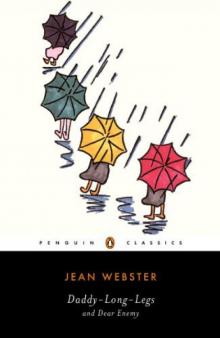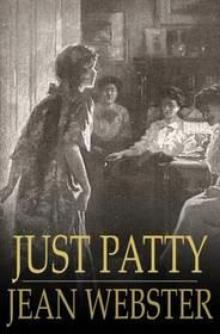- Home
- Jean Webster
The Wheat Princess
The Wheat Princess Read online
Produced by David Edwards, Emmy and the Online DistributedProofreading Team at https://www.pgdp.net (This file wasproduced from images generously made available by TheInternet Archive)
------------------------------------------------------------------------
_BY THE SAME AUTHOR_
DEAR ENEMY DADDY LONG LEGS JUST PATTY PATTY AND PRISCILLA THE FOUR POOLS MYSTERY JERRY MUCH ADO ABOUT PETER
LONDON HODDER AND STOUGHTON
------------------------------------------------------------------------
THE WHEAT PRINCESS
By JEAN WEBSTER Author of 'Daddy Long Legs,' 'Just Patty,' 'Dear Enemy'
HODDER AND STOUGHTON LIMITED LONDON
------------------------------------------------------------------------
O. HENRY
"The time is coming, let us hope, when the whole English-speaking world will recognise in O. HENRY one of the greatest masters of modern fiction."
STEPHEN LEACOCK.
HODDER & STOUGHTON publish all the books by O. HENRY in their famous Popular Series
THE FOUR MILLION THE TRIMMED LAMP SIXES AND SEVENS STRICTLY BUSINESS ROADS OF DESTINY CABBAGES AND KINGS HEART OF THE WEST THE GENTLE GRAFTER OPTIONS WHIRLIGIGS THE VOICE OF THE CITY ROLLING STONES
Cloth LONDON: HODDER AND STOUGHTON
------------------------------------------------------------------------
PROLOGUE
IF you leave the city by the Porta Maggiore and take the ViaPraenestina, which leads east into the Sabine hills, at some thirty-sixkilometers' distance from Rome you will pass on your left a grey-walledvillage climbing up the hillside. This is Palestrina, the old RomanPraeneste; and a short distance beyond--also on the left--you will findbranching off from the straight Roman highway a steep mountain road,which, if you stick to it long enough, will take you, after manywindings, to Castel Madama and Tivoli.
Several kilometers along this road you will see shooting up from a barecrag above you a little stone hamlet crowned by the ruins of amediaeval fortress. The town--Castel Vivalanti--was built in the dayswhen a stronghold was more to be thought of than a water-supply, andits people, from habit or love, or perhaps sheer necessity, have livedon there ever since, going down in the morning to their work in theplain and toiling up at night to their homes on the hill. So steep isits site that the doorway of one house looks down on the roof of thehouse below, and its narrow stone streets are in reality flights ofstairs. The only approach is from the front, by a road which winds andunwinds like a serpent and leads at last to the Porta della Luna,through which all of the traffic enters the town. The gate isornamented with the crest of the Vivalanti--a phoenix rising out of theflame, supported by a heavy machicolated top, from which, in the olddays, stones and burning oil might be dropped upon the heads of theunwelcome guests.
The town is a picturesque little affair--it would be hard to find aplace more so in the Sabine villages, it is very, very poor. In themarch of the centuries it has fallen out of step and been left farbehind; to look at it, one would scarcely dream that on the clear daysthe walls and towers of modern Rome are in sight on the horizon. But inits time Castel Vivalanti was not insignificant. This little hamlet hasentertained history within its walls. It has bodily outfaced robberbarons and papal troops. It has been besieged and conquered, and, alas,betrayed--and that by its own prince. Twice has it been razed to theground and twice rebuilt. In one way or another, though, it hasweathered the centuries, and it stands to-day grey and forlorn,clustering about the walls of its donjon and keep.
Castel Vivalanti, as in the middle ages, still gives the title to aRoman prince. The house of Vivalanti was powerful in its day, and theprinces may often be met with--not always to their credit--in thehistory of the Papal States. They were oftener at war than at peacewith the holy see, and there is the story of one pope who spent fourweary months watching the view from a very small window in Vivalanti'sdonjon. But, in spite of their unholy quarrels, they were at timesdevout enough, and twice a cardinal's hat has been worn in the family.The house of late years has dwindled somewhat, both in fortune andimportance; but, nevertheless, Vivalanti is a name which is stillspoken with respect among the old nobles of Rome.
The lower slopes of the hill on which the village stands are wellwooded and green with stone-pines and cypresses, olive orchards andvineyards. Here the princes built their villas when the wars with thepopes were safely at an end and they could risk coming down from theirstronghold on the mountain. The old villa was built about a mile belowthe town, and the gardens were laid out in terraces and parterres alongthe slope of the hill. It has long been in ruin, but its foundationsstill stand, and the plan of the gardens may easily be traced. You willsee the entrance at the left of the road--a massive stone gatewaytopped with moss-covered urns and a double row of cone-shaped cypressesbordering a once stately avenue now grown over with weeds. If you pausefor a moment--and you cannot help doing so--you will see, between theportals at the end of the avenue, some crumbling arches, and even, ifyour eyes are good, the fountain itself.
Any contadino that you meet on the road will tell you the story of theold Villa Vivalanti and the 'Bad Prince' who was (by the grace of God)murdered two centuries ago. He will tell you--a story not uncommon inItaly--of storehouses bursting with grain while the peasants werestarving, and of how, one moonlight night, as the prince was strollingon the terrace contentedly pondering his wickednesses of the day, apeasant from his own village up on the mountain, creeping behind him,quiet as a cat, stabbed him in the back and dropped his body in thefountain. He will tell you how the light from the burning villa wasseen as far as Rocca di Papa in the Alban hills; and he will add, witha laugh and a shrug, that some people say when the moon is full the oldprince comes back and sits on the edge of the fountain and thinks ofhis sins, but that, for himself, he thinks it an old woman's tale.Whereupon he will cast a quick glance over his shoulder at the darkshadow of the cypresses and covertly cross himself as he wishes you,'_A revederla_.'
You cannot wonder that the young prince (two centuries ago) did notbuild his new villa on the site of the old; for even had he, like thebrave contadino, cared nothing for ghosts, still it was scarcely ahallowed spot, and lovers would not care to stroll by the fountain. Soit happens that you must travel some distance further along the sameroad before you reach the gates of the new villa, built anno domini1693, in the pontificate of his Holiness Innocent XII. Here you willfind no gloomy cypresses: the approach is bordered by spreadingplane-trees. The villa itself is a rambling affair, and, thoughslightly time-worn, is still decidedly imposing, with its variouswings, its balconies and loggia and marble terrace.
The new villa--for such one must call it--faces west and north. On thewest it looks down over olive orchards and vineyards to the RomanCampagna, with the dome of St. Peter's a white speck in the distance,and, beyond it, to a
narrow, shining ribbon of sea. On the north itlooks up to the Sabine mountains, with the height of Soracte risinglike an island on the horizon. For the rest, it is surrounded by laureland ilex groves with long shady walks and leafy arbors, with fountainsand cascades and broken statues all laid out in the stately formalityof the seventeenth century. But the trees are no longer so carefullytrimmed as they were a century ago; the sun rarely shines in thesegreen alleys, and the nightingales sing all day. Through every season,but especially in the springtime, the garden-borders are glowing withcolour. Hedges of roses, oleanders and golden laburnum, scarletpomegranate blossoms and red and white camellias, marguerites andlilies and purple irises, bloom together in flaming profusion. Andtwice a year, in the spring and the autumn, the soft yellow walls ofthe villa are covered with lavender wistaria and pink climbing roses,and every breeze is filled with their fragrance.
It is a spot in which to dream of old Italy, of cardinals and pages andgorgeous lackeys, of gallant courtiers and beautiful ladies, of Romeosand Juliets trailing back and forth over the marble terrace and makinglove under the Italian moon. But if there have been lovers, as isdoubtless the case, there have also been haters among the Vivalanti,and you may read of more than one prince murdered by hands other thanthose of his peasants. The walls of the new villa, in the course oftheir two hundred years, have looked down on their full share oftragedies, and the Vivalanti annals are grim reading withal.
And now, having pursued the Vivalanti so far, you may possibly bedisappointed to hear that the story has nothing to do with them. But ifyou are interested in learning more of the family you can find hisExcellency Anastasio di Vivalanti, the present prince and the last ofthe line, any afternoon during the season in the casino at Monte Carlo.He is a slight young man with a dark, sallow face and many fine linesunder his eyes.
Then why, you may ask, if we are not concerned with the Vivalanti, havewe lingered so long in their garden? Ah--but the garden does concernus, though the young prince may not; and it is a pleasant spot, youmust acknowledge, in which to linger. The people with whom we areconcerned are (I hesitate to say it for fear of destroying the glamour)an American family. Yes, it is best to confess it boldly--are Americanmillionaires. It is out--the worst is told! But why, may I ask in myturn, is there anything so inherently distressing in the idea of anAmerican family (of millionaires) spending the summer in aseventeenth-century Italian villa up in the Sabine hills--especiallywhen the rightful heir prefers _trente-et-un_ at Monte Carlo? Must theyof necessity spoil the romance? They are human, and have their passionslike the rest of us; and one of them at least is young, and men havecalled her beautiful--yes, in this very garden.

 Daddy-Long-Legs & Dear Enemy
Daddy-Long-Legs & Dear Enemy Daddy-Long-Legs
Daddy-Long-Legs The Wheat Princess
The Wheat Princess Jerry
Jerry Just Patty
Just Patty